Dec 30, 2014 | coins, commemorative, commentary, legislative, policy, US Mint
And now, the end is near
And so I face the final curtain.
My friend, I’ll say it clear
I’ll state my case, of which I’m certain. . .
 As we wind down the end of a very interesting 2014, we also come to the end of the 113th Congress. This congress has been as inactive as any. Sure, there was a lot of press with faces from both sides spewing scary rhetoric about topics these people seem to know little about, but even when it comes to coining money, they have done less than any congress in recent memory.
As we wind down the end of a very interesting 2014, we also come to the end of the 113th Congress. This congress has been as inactive as any. Sure, there was a lot of press with faces from both sides spewing scary rhetoric about topics these people seem to know little about, but even when it comes to coining money, they have done less than any congress in recent memory.
Other than the passing the budget bill nicknamed “CRomnibus,” the 113th Congress passed only three bills that made it to the President’s desk. President Obama signed all three bills.
Bills Signed Into Law
- Public Law 113-10 (formerly H.R. 1071: To specify the size of the precious-metal blanks that will be used in the production of the National Baseball Hall of Fame commemorative coins. This was a technical change in the law that changed how the size of the planchet was determined that were not able to be considered when the law was introduced. This bill was signed into law by the President on May 17, 2013.
- Public Law 113-212 formerly H.R. 2366): The World War I American Veterans Centennial Commemorative Coin Act requires the Secretary of the Treasury to mint coins in commemoration of the centennial of World War I. In 2018, the U.S. Mint will strike not more than 350,000 silver dollar coins “emblematic of the centennial of America’s involvement in World War I.” The $10 per coin surcharge will be paid to the U.S. Foundation for the Commemoration of the World Wars to assist the World War I Centennial Commission in commemorating the centenary of World War I. This bill was signed into law by the President on December 16, 2014.
- Public Law 113-288 (formerly H.R. 2754: the Collectible Coin Protection Act. As I previously explained, this law enhances the Hobby Protection Act by allowing law enforcement and other legal actions against distributors and handlers of counterfeit coins and grading service holders. President Obama signed this bill into law on December 19, 2014.
Bills Passed by the House of Representatives
The following bill was passed by the House of Representatives but died in committee in the Senate.
- H.R. 2866: Boys Town Centennial Commemorative Coin Act
Bills Introduced in the House of Representatives
These are the bills that were introduced in the House of Representatives but died in the various committees. While it may not be apparent from the titles, all of these bills have some impact on the coinage that would be produced by the U.S. Mint:
- H.R. 77: Free Competition in Currency Act of 2013
- H.R. 220: Stop the Coin Act
- H.R. 627: National Park Service 100th Anniversary Commemorative Coin Act
- H.R. 1218: Commemorative Coins Reform Act of 2013
- H.R. 1653: Pro Football Hall of Fame Commemorative Coin Act
- H.R. 1719: Cents and Sensibility Act
- H.R. 1905: Mother’s Day Centennial Commemorative Coin Act
- H.R. 2366: World War I American Veterans Centennial Commemorative Coin Act
- H.R. 2633: Thirteenth Amendment Commemorative Coin Act
- H.R. 2760: Panama Canal and Pan-Pacific Exhibition Centennial Celebration Act
- H.R. 2932: United States Coast Guard Commemorative Coin Act
- H.R. 3146: Savings, Accountability, Value, and Efficiency (SAVE) II Act
- H.R. 3305: Currency Optimization, Innovation, and National Savings Act
- H.R. 3680: Breast Cancer Awareness Commemorative Coin Act
- H.R. 3729: Korean Immigration Commemorative Coin Act
Bills Introduced in the Senate
Coinage bills are considered revenue bills because they earn the federal government money and are used to raise funds that are paid by the government to public and private organizations. Even though the United States Constitution requires revenue bills to begin in the House of Representatives, it is not beneath the Senate to introduce their own legislation. Sometimes, senators introduce concurrent bills—bills that are similar to the one introduced in the House as a mechanism to get one of them passed. These are the bills that were introduced in the Senate that died in committee:
- S. 94: To terminate the $1 presidential coin program
- S.203: Pro Football Hall of Fame Commemorative Coin Act
- S. 768: Sound Money Promotion Act
- S. 1011: Boys Town Centennial Commemorative Coin Act
- S. 1105: Currency Optimization, Innovation, and National Savings Act
- S. 1158: National Park Service 100th Anniversary Commemorative Coin Act
- S. 1842: Pro Football Hall of Fame Commemorative Coin Act
- S. 2303: United States Coast Guard Commemorative Coin Act
- S. 2310: Mother’s Day Commemorative Coin Act
With that, we close the books on the 113th Congress.
Dec 20, 2014 | coins, counterfeit, legislative
With the midterm elections behind and the anticipation of the changes, congress still had work to do in the lame duck session. Over the last few sessions, congress has been their most productive during lame duck session as polling and focus groups has lead to those running for re-election to fearing the fast moving news cycles. Even the least controversial measures can be side tracked when members think that someone is watching that could misconstrue even the best of intentions.
But good things come to those who wait. Monday afternoon, December 15, 2014, H.R. 2754, the Collectible Coin Protection Act was passed in the Senate. The bill is on the way to the White House for President Obama’s signature, which should be a formality. The Collectible Coin Protection Act was first introduced to in the U.S. House of Representatives on May 7, 2013 to amend and updates the Hobby Protection Act that was passed over 30 years ago. The new law will allow law enforcement to take criminal action and individuals to take civil action against manufacturers, importers, and sellers of counterfeit coins and bullion products. It also allows the enforcement against the unauthorized use of registered trademarks belonging to collectible certification services.
Given the changes in the way we do business today, one of the more significant issues with the Hobby Protection Act is that only the manufacturers of the counterfeits could be prosecuted. In most cases, the manufactures of these counterfeits are hiding behind the Great Wall out of the legal reach of United States law enforcement. The Collectible Coin Protection Act will update the law to add the sellers and distribution of those coins to the targets of enforcement. If we cannot get to the makers of these fakes, then those who distribute that contraband can be prosecuted.
Further expanding the legal net to catch the scofflaws is the new provision to include “any person who provides substantial assistance or support to any manufacturer, importer, or seller” who knowingly engages in any act that violates this law. In other words, this adds the accomplices and those who support any part of the act of production and selling counterfeit United State coins.
If you buy a counterfeit coins, you can now take action against the the counterfeiter, their agents, the seller, and anyone else in the supply chain who was involved in the manufacture and sale of the coin. Even if you unwhittingly buy the counterfeit coin via an online auction and attempt to flip it hoping to recover your money, the buyer can sue you as the seller of contraband. To help fight the counterfeiting of third-party certification service holders, the act extends trademark violation and the ability to sue for remedies.
These new provisions will allow collectors, dealers, and grading services to bring legal actions that are much more effective, with much stronger remedies than previously existed. It will allow those harmed to work with the Justice Department to bring criminal actions where appropriate.
Congress engrossed the bill and sent it to the White House on December 15, 2014. It is currently waiting for President Obama’s signature. It will be a good present to the holiday when he signs this bill into law.
Examples of Chinese Counterfeits
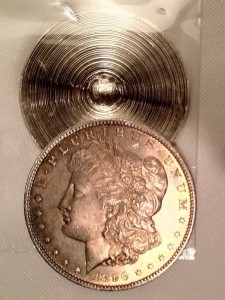
An example of a Morgan Dollar cut in half to match a date with a mintmark to have the coin appear something it is not. Coin was in a counterfeit PCGS slab and caught by one of their graders.
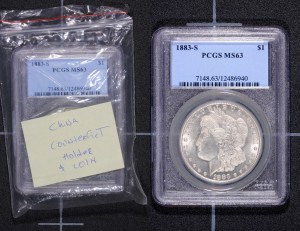
PCGS representatives showed Congressmen counterfeit U.S. coins in counterfeit PCGS holders during their recent meetings in Washington, DC. (Photo courtesy of PCGS.)
Dec 11, 2014 | BEP, legislative, news, US Mint
In a normal world, the United States congress will pass twelve different budget bills by August or September in time for the beginning of the federal government’s fiscal year, which begins on October 1. Anyone who has followed congress over the last 20-or-more years knows that the world they live in is not normal. Rather than pass real budget bills, congress has learned the irresponsible habit of voting on continuing resolutions and omnibus funding bills.
A continuing resolution (CR) is a bill that says to take the previously passed budget and extend it to a specific date. CRs can either continue the spending or make certain adjustments, such as reducing spending by a percentage. Omnibus, from the Latin “for everything,” are bills that are loaded with every bit of budget information in one very long bill.
Within the Omnibus budget bill are provisions to provide funding for the government’s money manufacturing operations. But this is different type of bill. It is an omnibus spending bill that covers most of the government through the end of this fiscal year (September) and a CR for the Department of Homeland Security so that the new congress can fight with the president over other policy matters. Reporters have been calling this a CRomnibus bill—which should never be confused with a cronut which is a very sweet treat! According to NBC News:
And the Washington word of the week is: “Cromnibus.” It’s the love child of a “continuing resolution” (CR) and “ omnibus” spending bill, two inside-the-Beltway terms for measures Congress has approved to keep the government funded.
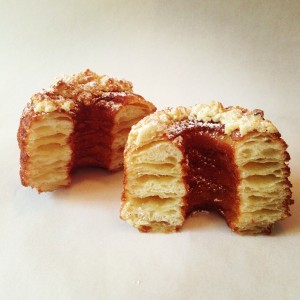
TASTY!
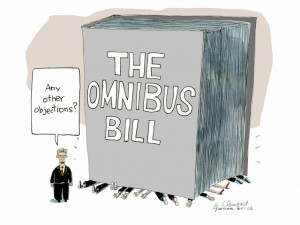
Not so tasty!
For the U.S. Mint, the bill recognizes that their funding is provided by its seigniorage that is deposited in the United States Mint Public Enterprise Fund (31 U.S.C § 5136) and does not receive appropriations from the general Treasury. Congress can limit the amount that the U.S. Mint can spend from the Public Enterprise Fund. In the Omnibus Budget Bill waiting for congress to vote on, the U.S. Mint is limited to spending $20 million.
In the grand scheme of the U.S. federal government, $20 million is not a lot of money. However, it may be more than enough for the U.S. Mint to operate. According most fiscal year 2013 (FY13) annual report from the U.S. Mint, the latest report available when this is written, the U.S. Mint spent $11.89 million for FY13 and $12.03 million in FY12. If the cost cutting measures implemented by Deputy Director Richard Peterson this past year further reduces costs, the $20 million could be twice as much as the U.S. Mint needs to operate.
Appropriation for the Bureau of Engraving and Printing has a few different provisions. Although it does recognize that the BEP has what the bill calls an “industrial fund,” (31 U.S. Code § 5142), the bill does not place many limits on what the BEP can use. The bill says that the BEP cannot use the monies to redesign the $1 Federal Reserve Note making it the second oldest design used on U.S. money.
For double-extra brownie points, what is the oldest design used on U.S. money?
The other limit is that the BEP can use only up to $5,000 for “official reception and representation expenses.” Essentially, the BEP can only spend up to $5,000 for conferences and conference attendance. Does this mean that the BEP will not be at shows like the World’s Fair of Money because it would cost more than the $5,000 to bring their exhibit to Rosemont, Illinois next August? If the BEP does not attend the World’s Fair of Money or other shows, tell your representatives in congress that their short-sightedness is hurting the hobby!
Finally, the bill says that the money appropriated “may be used to consolidate any or all functions of the Bureau of Engraving and Printing and the United States Mint without the explicit approval of the House Committee on Financial Services; the Senate Committee on Banking, Housing, and Urban Affairs; and the Committees on Appropriations of the House of Representatives and the Senate.” In other words, if someone figures out that the BEP and U.S. Mint can become more efficient and further save money by combining certain functions they have to go to congress and ask for permission.
I wonder what congress would say if the BEP and U.S. Mint were to propose to consolidate their online and brick-and-mortar retail operations? Instead of two different operations, how much could be saved if these bureaus under the Department of the Treasury would have one fulfillment contractor or a combined storefront in their current locations?
Of course this is contingent on congress passing this budget. As I write this, the government is a few hours away from running out of money with no signs of being able to pass this bill. However, if the government shuts down the U.S. Mint and BEP will continue operating since they are self-funded organizations.
UPDATE: (12/12/14 00:45) The CRomnibus bill passed the House about 10:00 PM on Thursday but still needs to be passed by the Senate before it can be signed by the President into law. The House passed a stop-gap bill to give the Senate until this weekend to pass the CRomnibus bill. Crisis averted, but the money manufacturing process continues.
Image of the Cronut courtesy of
Dominique Ansel Bakery, where it was invented.
Cartoon about the Omnibus bill is actually Canadian by Gary Clement and appeared in the
National Post. Who cares if it’s Canadian. It’s fitting!
Oct 6, 2014 | coins, commemorative, legislative
With apologies for my absence, the end of the federal fiscal year has made me very busy. I have a few posts I am getting ready to queue up that I hope will be of interest. I appreciate your patience and hope to provide you with something interesting to read soon. In the mean time, here’s what congress did that is of interest to the numismatic community:
H.R. 2866: Boys Town Centennial Commemorative Coin Act
Sponsor: Rep. Lee Terry (R-NE)
• To require the Secretary of the Treasury to mint coins in commemoration of the centennial of Boys Town.
• Passed by the House of Representatives on September 15, 2014
• Received in the Senate on September 16, 2014
• Referred to the Senate Banking, Housing, and Urban Affairs Committee
Track this bill at https://www.govtrack.us/congress/bills/113/hr2866
Jul 7, 2014 | legislative, policy
 At the beginning of each month, I like to provide my readers with a progress with coin or coin industry-related legislation being considered in congress. For the third time this session, there were no new coin-related bills introduced and those that have been submitted have not seen any legislative action. Considering congress has begun their summer break, there will probably be nothing to report for this month.
At the beginning of each month, I like to provide my readers with a progress with coin or coin industry-related legislation being considered in congress. For the third time this session, there were no new coin-related bills introduced and those that have been submitted have not seen any legislative action. Considering congress has begun their summer break, there will probably be nothing to report for this month.
In similar news, on September 12, 2014, Richard A. Peterson, Deputy Director of the United States Mint provided a status to the House Financial Services Committee about the Alternative Metals Study. The only news to come out of the hearing was the recommendation by Rep. Steve Stivers (R-OH) to use steel as a coinage metal. Stivers was reported to have said, “Steel costs about $900 a ton versus some of the other metals that cost up to $5,000 a ton or $12,000 a ton.”
Prior to the hearing, the U.S. Mint extended the deadline for public comment on the Alternative Metals Study. Predictably, representatives for the vending and coin-operated machine industries called on the U.S. Mint and the congress to maintain the status quo.
Outside of Washington, there is an issue with the enforcement of a consumer protection law in Minnesota that requires dealers with more than $5,000 in sales of bullion coins to register in Minnesota. One of the problems with the definition is that the Minnesota law defines “Bullion Coin” as “any coin containing more than one percent by weight of silver, gold, platinum, or other precious metal.” (see Minnesota Stat. §80G.01 Subd. 2). This means that dealers selling more than $5,000 of Mercury dimes or Barber quarters are required to register the same way as those selling American Eagle coins.
To learn more about this issue, I recommend a reading “Dealers to reject Minnesota clients” by Pat Heller that was published in Numismatic News. There will be more on this and similar laws in other states in future posts.
In keeping with the legislative theme, the following is what has been considered by the 113th congress thus far:
Bills Signed into Law
The following has passed both the House of Representatives and Senate and has been signed by the President of the United States into law:
- Public Law 113-10 (formerly H.R. 1071: To specify the size of the precious-metal blanks that will be used in the production of the National Baseball Hall of Fame commemorative coins.
Bills Passed in the House of Representatives
The following bill passed the House and is awaiting action in the Senate:
Introduced in the House of Representatives
- H.R. 77: Free Competition in Currency Act of 2013
- H.R. 220: Stop the Coin Act
- H.R. 627: National Park Service 100th Anniversary Commemorative Coin Act
- H.R. 1218: Commemorative Coins Reform Act of 2013
- H.R. 1653: Pro Football Hall of Fame Commemorative Coin Act
- H.R. 1719: Cents and Sensibility Act
- H.R. 1905: Mother’s Day Centennial Commemorative Coin Act
- H.R. 2366: World War I American Veterans Centennial Commemorative Coin Act
- H.R. 2633: Thirteenth Amendment Commemorative Coin Act
- H.R. 2760: Panama Canal and Pan-Pacific Exhibition Centennial Celebration Act
- H.R. 2932: United States Coast Guard Commemorative Coin Act
- H.R. 3146: Savings, Accountability, Value, and Efficiency (SAVE) II Act
- H.R. 3305: Currency Optimization, Innovation, and National Savings Act
- H.R. 3680: Breast Cancer Awareness Commemorative Coin Act
- H.R. 3729: Korean Immigration Commemorative Coin Act
Introduced in the Senate
Even though financial bills are constitutionally required to begin in the House of Representatives, it is not beneath the Senate to introduce their own legislation or concurrent bills with the House. Coin-related bills introduced in the Senate are usually referred to the Senate Committee on Banking, Housing, and Urban Affairs. The bills introduced in the Senate are as follows:
- S. 94: To terminate the $1 presidential coin program
- S.203: Pro Football Hall of Fame Commemorative Coin Act
- S. 768: Sound Money Promotion Act
- S. 1011: Boys Town Centennial Commemorative Coin Act
- S. 1105: Currency Optimization, Innovation, and National Savings Act
- S. 1158: National Park Service 100th Anniversary Commemorative Coin Act
- S. 1842: Pro Football Hall of Fame Commemorative Coin Act
- S. 2303: United States Coast Guard Commemorative Coin Act
- S. 2310: Mother’s Day Commemorative Coin Act
Jun 4, 2014 | coins, commemorative, legislative, policy, US Mint
S. 2303: United States Coast Guard Commemorative Coin Act
Sponsor: Sen. Christopher Murphy (D-CT)
• To require the Secretary of the Treasury to mint coins in commemoration of the United States Coast Guard
• Introduced: May 7, 2014
• Referred to the Senate Committee on Banking, Housing, and Urban Affairs
Track this bill at https://www.govtrack.us/congress/bills/113/s2303
S. 2310: Mother’s Day Commemorative Coin Act
Sponsor: Sen. John “Jay” Rockefeller IV (D-WV)
• To require the Secretary of the Treasury to mint coins in commemoration of Mother’s Day
• Introduced: May 8, 2014
• Referred to the Senate Committee on Banking, Housing, and Urban Affairs
Track this bill at https://www.govtrack.us/congress/bills/113/s2310
Note that the likelihood of these bills passing is slim-to-none and Slim just left town. Since Sen. Rockefeller is retiring after this session, there is a small chance that Mother’s Day commemorative could be voted on by unanimous consent in December as a legislative “going away present.”
May 5, 2014 | coins, commemorative, legislative, policy, US Mint
Our long national nightmare is over, congress finally passed some sort of numismatic-related legislation. But do not get too excited because today’s news out of the House of Representatives is only the beginning. Next is for the Senate to do nothing while the bill languishes in committee.
H.R. 627: National Park Service 100th Anniversary Commemorative Coin Act
Sponsor: Rep. Erik Paulsen (R-MN)
• To provide for the issuance of coins to commemorate the 100th anniversary of the establishment of the National Park Service.
• Passed the House of Representatives: April 29, 2014
• Received in the Senate on April 29, 2014 and referred to the Senate Committee on Banking, Housing, and Urban Affairs
Track this bill at https://www.govtrack.us/congress/bills/113/hr627
Apr 10, 2014 | coins, commemorative, commentary, legislative, policy, US Mint
 Amongst all of the noise on Capitol Hill, the one area where no noise has been made is in the numismatic arena. For the last three months there has been no bill introduced, heard in committee, or acted on by either chamber of congress. Although there have been some hearings on a few issues, the last numismatic-related bill that had any congressional action was the introduction of the Pro Football Hall of Fame Commemorative Coin Act, S. 1842, introduced by Sen. Rob Portman (R-OH) in December.
Amongst all of the noise on Capitol Hill, the one area where no noise has been made is in the numismatic arena. For the last three months there has been no bill introduced, heard in committee, or acted on by either chamber of congress. Although there have been some hearings on a few issues, the last numismatic-related bill that had any congressional action was the introduction of the Pro Football Hall of Fame Commemorative Coin Act, S. 1842, introduced by Sen. Rob Portman (R-OH) in December.
This type of inactivity is unusual for congress. Regardless of party, congress is always looking to curry favor with their constituents and groups associated with their constituents by introducing commemorative coin legislation. Over the last few congresses (a two-year term), there will be over 40 coin-related bills that die in committee where very few even get a cursory hearing.
This does not mean there will be no commemorative coins in the near future. Now, the U.S. Mint has issued the Civil Rights Act of 1964 Silver Dollar and National Baseball Hall of Fame commemoratives. In fact, the Baseball Hall of Fame coins are so popular that the gold option has sold out of its 50,000 statutory mintage limit.
As an aside, a friend pointed out that the U.S. Mint did not bring 50,000 gold coins to the Whitman Baltimore Expo and wondered how many of those coins were purchased by baseball’s owners and members of the Baseball Hall of Fame. It would be interesting to see the effect of organized baseball on the sale of these coins.
In 2015, the U.S. Mint is scheduled to release a March of Dimes Commemorative Silver Dollar commemorative coin. Founded in 1938 by President Franklin D. Roosevelt to combat polio, the March of Dimes changed its mission to combating birth defects after the discovery of the polio vaccine by Dr. Jonas Salk in 1954. Salk’s work was supported by the organization.
Also on the schedule for 2015 is the United States Marshals Service 225th Anniversary commemorative coin series. The Marshal Service commemoratives will include a gold $5, silver dollar, and clad half-dollar coins. I do not think this will be as popular as the 2005 Marine Corps 30th Anniversary commemorative coins.
Officially, the 2016 scheduled commemorative will be the Mark Twain Commemorative coin program that will only include gold $5 and silver dollar coins. However, considering Twain’s mindset about being famous, I think he would be amused by having a commemorative coin made in his honor. I might call it the “Mark Twain Amusement commemorative.”
The only other commemorative coin with legislation that has passed congress and signed by the president is the 2017 Lions Clubs International Century of Service Silver Dollar.
Given the law says that there will be no more than two commemorative coin series per year (31 U.S.C. §5112(m)); and given that the next time only one commemorative coin is scheduled to be issues is in 2016, there is plenty of time for congress to do “something” and pass one of the bills that is currently waiting for their action.
Jan 2, 2014 | coins, legislative, policy, US Mint
H.R. 3680: Breast Cancer Awareness Commemorative Coin Act
Sponsor: Rep. Carolyn Maloney (D-NY)
• To require the Secretary of the Treasury to mint coins in recognition of the fight against breast cancer.
• Introduced: December 9, 2013
• Referred to the House Committee on Financial Services
Track this bill at https://www.govtrack.us/congress/bills/113/hr3680
H.R. 3729: Korean Immigration Commemorative Coin Act
Sponsor: Rep. Robert “Rob” Andrews (D-NJ)
• To require the Secretary of the Treasury to mint coins in commemoration of the 100th anniversary of the beginning of Korean immigration into the United States.
• Introduced: December 12, 2013
• Referred to the House Committee on Financial Services
Track this bill at https://www.govtrack.us/congress/bills/113/hr3729
S. 1842: Pro Football Hall of Fame Commemorative Coin Act
Sponsor Sen. Robert “Rob” Portman (R-OH)
• A bill to require the Secretary of the Treasury to mint coins in recognition and celebration of the Pro Football Hall of Fame.
• Introduced: December 17, 2013
• Referred to the Senate Banking, Housing, and Urban Affairs Committee
Track this bill at https://www.govtrack.us/congress/bills/113/s1842
Dec 29, 2013 | Canada, coins, counterfeit, legislative, RCM
Counterfeiting coins and currency has been a problem for both the government and the numismatic industry. Government has shown it will go to extensive lengths in order to change the $100 note in order to stop currency counterfeiting. In fact, currency has had a long history of trying to fight currency counterfeiting.
For collectors of United States coins, there is a problems with the counterfeiting of classic coins primarily from China. In China, it is legal to reproduce obsolete
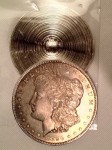
An example of a Morgan Dollar cut in half to match a date with a mintmark to have the coin appear something it is not. Coin was in a counterfeit PCGS slab and caught by one of their graders.
Those who create counterfeit coins are not making “tributes,” as has been the stance of the Chinese government. They are reproducing rarities and trying to pass them as real coins. In some cases, these counterfeiters are even trying reproduce the third-party grading service slabs in order to get them past scrutiny.
In the United States, Industry Council for Tangible Assets and the Gold & Silver Political Action Committee has been working to have congress update the Hobby Protection Act (15 U.S.C §§ 2101-2106) to provide for more protection to the buyer. Aside from strengthening the requirement to have copies appropriately marked and marketed, it allows for duped buyers and the government to take action against the resellers. Currently, the Hobby Protection Act only allows for action against the manufacturers and not anyone else in the supply chain. By opening the supply chain to prosecution it is hoped that it will choke off the supply.
This past August, the House of Representatives passed the Collectible Coin Protection Act on a unanimous voice vote.
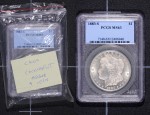
PCGS representatives showed Congressmen counterfeit U.S. coins in counterfeit PCGS holders during their recent meetings in Washington, DC. (Photo courtesy of PCGS.)
Collectible coins are not the only problem. Great Britain has been having problems since the issue of new £1 coins entering circulation starting in 2010. Even though arrests have been made, there remains an undetermined amount of counterfeit coins in circulation.
Last summer, counterfeiters were arrested in Greece and Turkey for producing fake 2 Euro coins. These counterfeits look very similar to the standard 2 Euro coin with the standard Greece reverse. A real 2 Euro coin is a bi-metalic coin that does not separate. The counterfeits will separate and are lighter than the real version.
In Canada, the Royal Canadian Mint has changed the Loonie and Toonie to include micro engraving to thwart counterfeiters. The RCM has also changed the composition of the coins which will help them last longer.
Counterfeit coins and currency will continue to be a problem. Every change, no matter how small, is not only good for the economy, it is good for the hobby.
-
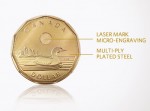
-
The new technology used by the Royal Canadian Mint to protect the Loonie ($)
-
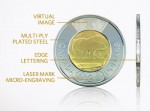
-
The new technology used by the Royal Canadian Mint to protect the Toonie (C$2)
 As we wind down the end of a very interesting 2014, we also come to the end of the 113th Congress. This congress has been as inactive as any. Sure, there was a lot of press with faces from both sides spewing scary rhetoric about topics these people seem to know little about, but even when it comes to coining money, they have done less than any congress in recent memory.
As we wind down the end of a very interesting 2014, we also come to the end of the 113th Congress. This congress has been as inactive as any. Sure, there was a lot of press with faces from both sides spewing scary rhetoric about topics these people seem to know little about, but even when it comes to coining money, they have done less than any congress in recent memory.



 At the beginning of each month, I like to provide my readers with a progress with coin or coin industry-related legislation being considered in congress. For the third time this session, there were no new coin-related bills introduced and those that have been submitted have not seen any legislative action. Considering congress has begun their summer break, there will probably be nothing to report for this month.
At the beginning of each month, I like to provide my readers with a progress with coin or coin industry-related legislation being considered in congress. For the third time this session, there were no new coin-related bills introduced and those that have been submitted have not seen any legislative action. Considering congress has begun their summer break, there will probably be nothing to report for this month.




